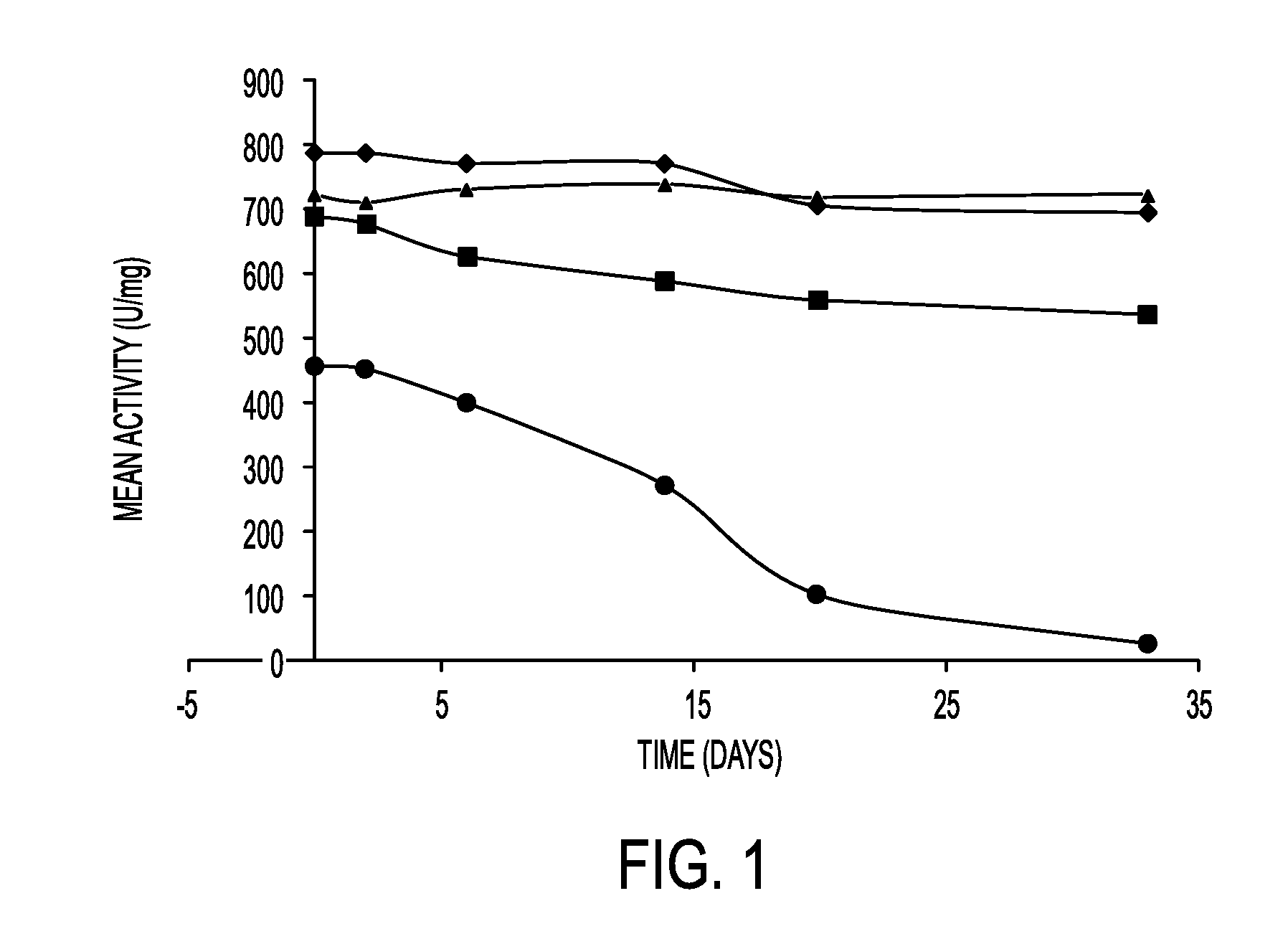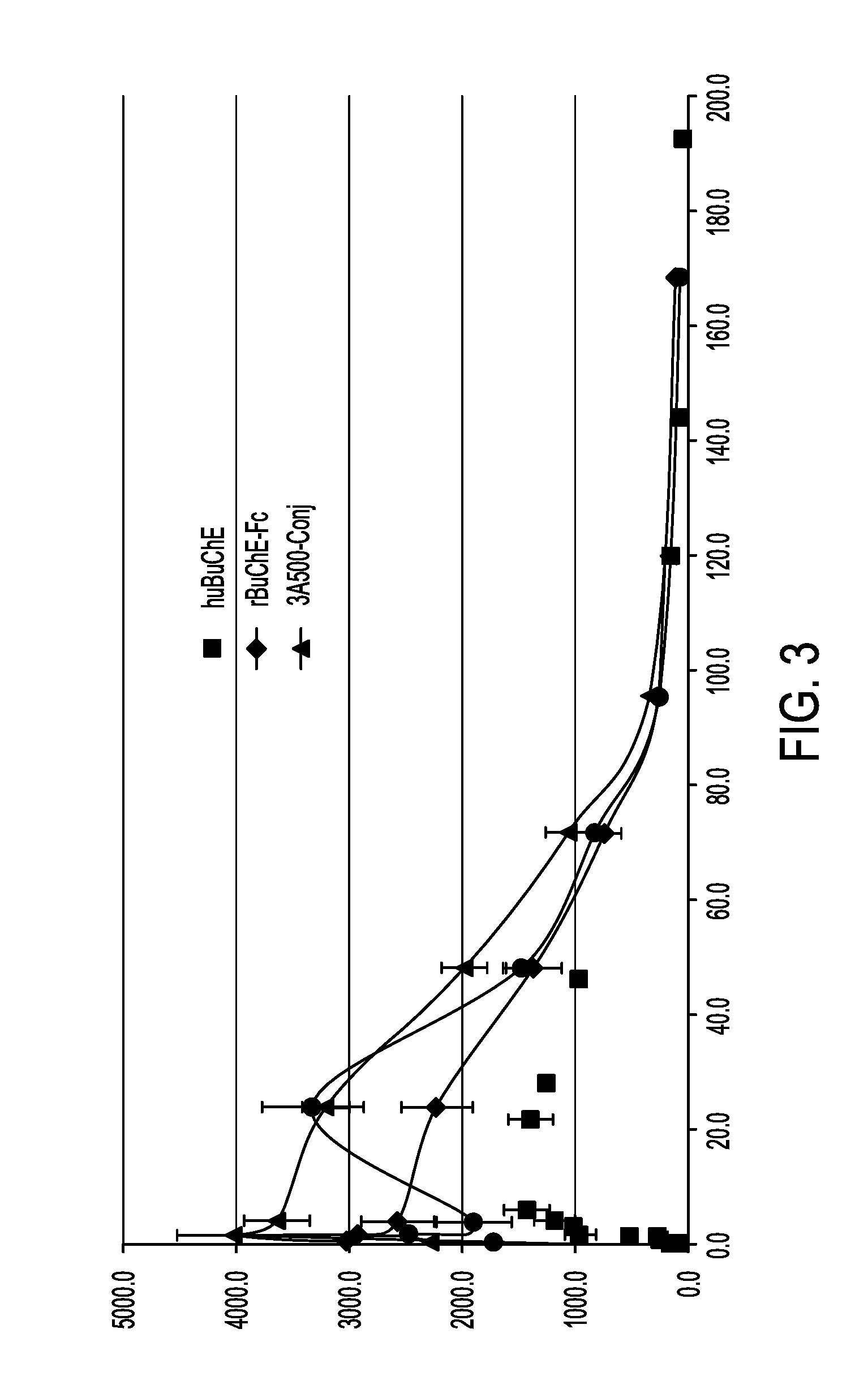Butyrylcholinesterase zwitterionic polymer conjugates
a technology of butyrylcholinesterase and polymer conjugate, which is applied in the direction of enzyme stabilisation, peptides, peptides/protein ingredients, etc., can solve the problems of ops being considered an ever increasing military and civilian threat, tokyo subway system was the subject of a sarin attack, and high toxicity of organic phosphorus compounds (ops) to humans
- Summary
- Abstract
- Description
- Claims
- Application Information
AI Technical Summary
Benefits of technology
Problems solved by technology
Method used
Image
Examples
example 1
rBuChE Truncations
[0208]An OP bioscavenger was made by truncating the hBuChE enzyme at position 524 (referring to the mature protein) (rhBuChE524). In addition, the mutation C66Y was introduced. The protein sequence of rhBuChE524 (C66Y) is shown in SEQ ID NO. 10. If it is desirable to conjugate a polymer to the rhBuChE524 (C66Y) a GGC or GGGC sequence (SEQ ID NO: 20) can be added on to the end. The protein sequence of rhBuChE524GGGC (C66Y) is shown in SEQ ID NO. 12 (“GGGC” disclosed as SEQ ID NO: 20).
[0209]Another bioscavenger was made by truncating hBuChE at position 534 (referring to the mature protein). The sequence of rhBuChE534 (C66Y) is shown in SEQ ID NO. 10. For conjugation to a polymer using cysteine, GGC is optionally added to the end. The protein sequence of rhBuChE534GGC (C66Y) is SEQ ID NO. 13.
example 2
rBuChE Fusion Proteins
[0210]A rhBuChE-Fc fusion protein was made by recombinant genetic engineering by using the 534 truncate described above and fusing it to the Fc region of IgG1 with a GS linker (GGGSGGGSGGGS) (SEQ ID NO:21) in between the two protein segments. The sequence rhBuChE534-Fc is shown in SEQ ID NO. 16. The fusion construct with the C66Y mutation (rhBuChE534 (C66Y)-Fc) is shown in SEQ ID NO. 17. In another version, various effector function mutations are introduced: L234A, L235E, G237A, A330S and P331S. The hBuChE534 (C66Y)-Fc(L234A, L235E, G237A, A330S and P331S) fusion is shown in SEQ ID NO. 15. Another mutation which can be engineered into the Fc portion of the protein is Q347C which can be used to conjugate polymers such as POLY(MPC) to the protein. The protein sequence of rhBuChE534 (C66Y)-Fc(L234A, L235E, G237A, A330S, P331S and Q347C) is shown in SEQ ID NO. 2.
[0211]The various protein constructs were expressed in CHO-K1 cells using appropriate DNA constructs for...
example 3
Transient Expression of Constructs
[0212]A transient expression analysis was performed in Expi293 Expression System (Gibco). The expression of a number of rhBuChE524 truncates was examined. In general, the rhBuChE524 constructs either were not expressed or were not expressed as well as the corresponding rhBuChE534 constructs. With regard to the rhBuChE534 constructs, it was found that the C66Y constructs were in generally better expressed than constructs without this change A summary of transient expression data for the 534 constructs is shown in the table below:
TABLE 1Ellman's Assay testConstruct(units / mL)rhBuChE53415rhBuChE534GGC7.5rhBuChE534GGC (C66Y)32rhBuChE534 (C66Y) - Fc (L234A,27L235E, G237A, A330S, P331S andQ347C)
PUM
| Property | Measurement | Unit |
|---|---|---|
| Mass | aaaaa | aaaaa |
| Mass | aaaaa | aaaaa |
| Mass | aaaaa | aaaaa |
Abstract
Description
Claims
Application Information
 Login to View More
Login to View More - R&D
- Intellectual Property
- Life Sciences
- Materials
- Tech Scout
- Unparalleled Data Quality
- Higher Quality Content
- 60% Fewer Hallucinations
Browse by: Latest US Patents, China's latest patents, Technical Efficacy Thesaurus, Application Domain, Technology Topic, Popular Technical Reports.
© 2025 PatSnap. All rights reserved.Legal|Privacy policy|Modern Slavery Act Transparency Statement|Sitemap|About US| Contact US: help@patsnap.com



